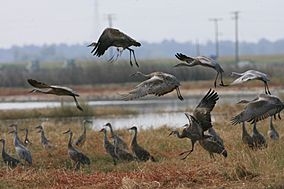Merced National Wildlife Refuge facts for kids
Quick facts for kids Merced National Wildlife Refuge |
|
|---|---|
|
IUCN Category IV (Habitat/Species Management Area)
|
|

A flock of sandhill cranes landing
|
|
| Location | Merced County, California, United States |
| Nearest city | Merced, California |
| Area | 10,262 acres (41.53 km2) |
| Established | 1951 |
| Governing body | U.S. Fish and Wildlife Service |
| Website | Merced National Wildlife Refuge |
The Merced National Wildlife Refuge is a special place in California. It covers about 10,262 acres (41.53 km2) of wetlands, grasslands, and unique vernal pools. This refuge was created in 1951. Its main goal was to attract waterfowl (like ducks and geese) away from nearby farms. The birds used to eat the farmers' crops, causing problems. Now, with better farming and refuge care, these issues are much smaller.
Contents
Home to Amazing Birds
The Merced National Wildlife Refuge is a very important stop for many birds. It hosts the largest groups of lesser sandhill cranes and Ross's geese on the Pacific Flyway. The Pacific Flyway is like a superhighway in the sky for migrating birds.
Winter Visitors
Every autumn, over 20,000 cranes and 60,000 geese fly here. They travel all the way from Alaska and Canada. They stay at the refuge for six months during the winter. Thousands of other waterfowl, waterbirds, and shorebirds also visit. This makes the refuge a truly amazing sight in winter.
Breeding Birds and Other Animals
The refuge is also a safe place for many birds to have their babies. These include Swainson's hawks, tri-colored blackbirds, marsh wrens, and burrowing owls. Tri-colored blackbirds are songbirds that nest in huge groups. Sometimes, over 25,000 pairs of them can be found here. You might also spot coyotes, ground squirrels, desert cottontail rabbits, and beavers all year long.
Wonderful Vernal Pools
Vernal pools are a special kind of wetland found at the refuge. These pools form in shallow dips in the ground. They have clay soil underneath. This soil holds winter rainwater, filling the pools.
Life in the Pools
When the pools fill with water, they become full of life. Tiny fairy and tadpole shrimp hatch from eggs. These eggs were hidden in the soil from the year before. The endangered tiger salamander and other amphibians lay their eggs here. The many small water creatures in these pools are food for birds. This helps them get ready for their long flight north to their breeding areas.
Spring Wildflowers
As spring arrives, the water in the vernal pools slowly dries up. Then, beautiful wildflowers start to grow. You can see goldfields, purple owl's clover, and butter-and-eggs. They grow in colorful rings around the dried-up pools. Once the pools are completely dry, rare plants like Downingia and Colusa grass appear. John Muir, a famous naturalist, once said this area was the "floweriest part of the world."
Helping Wildlife with Farming
The Merced National Wildlife Refuge does more than just protect natural areas. It also has about 300 acres (1.2 km2) of corn and winter wheat crops. There are also over 500 acres (2.0 km2) of irrigated pasture. These farmed areas are important food sources for the thousands of geese and cranes. They help the birds get enough energy for their long journey back north.
Working with Farmers
Local farmers help the refuge by planting and watering these crops. The refuge also uses a livestock grazing program. This means cattle and sheep are allowed to graze. Grazing helps control unwanted weeds. It also keeps the grasslands short for geese to eat. This helps native grasses grow better too.
![]() This article incorporates public domain material from websites or documents of the United States Fish and Wildlife Service.
This article incorporates public domain material from websites or documents of the United States Fish and Wildlife Service.


